Introduction to Energy Efficiency in New York
There are 8 million residential housing units in the state of New York that represent 1/3 of the state’s greenhouse gas (GHG) emissions from the energy required for heating and cooling.
In January 2020, the state’s Public Service Commission issued an order setting robust energy efficiency and building decarbonization targets to meet the state’s goal to achieve 185 TBtus in savings by 2025. This is equivalent to fueling and powering more than 1.8 million homes in the state of New York by 2025.
These goals are notable for being among the first in a next generation of fuel-neutral energy efficiency resource standards that integrate beneficial electrification and include a separate heat pump target.
This is not about replacing some light bulbs. We need to be retrofitting 200 buildings a day for the next 12,000 days.
Janet Joseph, NYSERDA
In order to meet the state’s climate action goals of reducing GHG emissions by 85% in 2050, 500 buildings per day would need to be retrofitted and decarbonized over the next 28 years.
The state of New York ranked 3rd in the 2022 State Energy Efficiency Scorecard, up by two places from its 2020 ranking. The state scored 39 points out of a possible 50, 2.5 points more than it earned in 2020. Furthermore, New York City (NYC) is consistently ranked one of the most energy efficient cities in the US, occupying the 2nd place in the American Council for an Energy Efficient Economy (ACEEE) ranking and the 5th place in the ENERGY STAR ranking.
“This is not about replacing some light bulbs,” says Janet Joseph, former Senior VP of Strategy and Market Development at the New York State Energy Research and Development Authority (NYSERDA). “We need to be retrofitting 200 buildings a day [in New York City], every day, for the next 12,000 days.”
Understanding the Purpose and the Audience of this Energy Efficiency Report
Why did we create this Energy Efficiency report for New York?
This report was created to be a single resource to reference to quickly find information about energy efficiency in New York State – its energy policies, climate goals, gas and electric utilities, their programs, their customers and demographics, and the building stock itself. We’ve gathered the most important New York energy efficiency information and compiled it into a single guide, with useful insights, opinions, resources, tools and more.
Who is the New York Energy Efficiency report for?
This comprehensive guide is designed for anyone interested in understanding the intricacies of energy efficiency in New York State, including gas and electric utilities across North America. Gain insights into effective energy efficiency strategies, key players, the regulatory environment’s impact on programming, and lessons to be learned from New York’s experience. If you’re seeking to explore the factors driving energy efficiency advancements in New York State, this guide is your go-to resource.
Who created this guide?
MyHEAT, a company dedicated to reducing energy consumption in heating and cooling buildings globally, created this guide focused on New York energy savings programs and energy efficiency in the state. Our team consists of industry experts with extensive qualifications and experience in energy efficiency, data analysis, and thermal imaging. Our thermal infrared Heat Loss Maps enable utilities and governments to engage energy consumers and drive program participation through personalized, visually appealing home energy reports with heat loss maps for individual buildings at the city scale.
In short, we make energy efficiency sexy – at least, according to Julie Roth (Senior Energy Analyst, Office of Sustainability and Innovations at City of Ann Arbor):
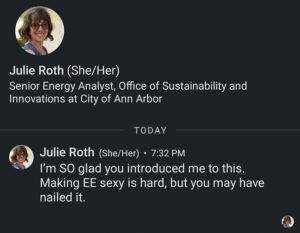
If you have any questions or find any discrepancies in the guide, please feel free to reach out to us. Our team is committed to maintaining the highest standards of industry knowledge and is always ready to assist you.
Last updated:
This report was last updated in July 2023.
New York’s Key Climate Goals and Timelines: A Roadmap to Sustainability
In July 2019, New York passed the Climate Leadership and Community Protection Act (the Climate Act, or CLCPA), an act described by New York’s Climate Council as “the most ambitious and comprehensive climate and clean energy legislation in the country.”
While New York City has over 85 individual climate-related proposals and goals, the new Climate Act law mandates the state to achieve several ambitious sustainability goals over the next 27 years.
Here are the most important and relevant energy and energy efficiency goals, grouped into different categories defined by the New York State Climate Act:
- By 2050, New York should reduce GHG emissions by 85% from a 1990 baseline, often referred to as the “85×50” commitment. This is probably the state’s most important sustainability goal.
- By 2030, achieve 70% carbon-free renewable energy generation across the state
- By 2040, 100% of the electricity on the state’s grid should be clean, zero-emission, carbon-free electricity. NYS estimates that reaching this goal will prevent 49 million tons of CO2 every year from being released.
- Achieve 22M tons of carbon reduction through Energy Efficiency and Electrification. Though a timeline is not provided for this goal, we can assume it relates to the goal of reducing statewide emissions by 85% by 2050.
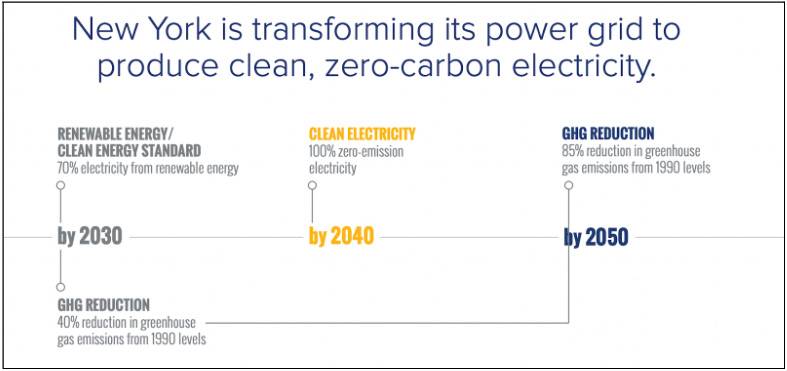
Following the enactment of the Climate Act, the New York Public Service Commission issued a new energy efficiency order in 2020 calling for 185 TBtus (Trillion BTUs) of energy savings by 2025. The American Council for an Energy Efficient Economy equates these savings to annual energy savings goals of 3% for electric and 1.3% for gas.
Achieving these goals will require the state to reduce GHG emissions economy-wide through electrification and energy efficiency, and simultaneously increase the share of solar, wind, hydro and geothermal energy supplied to the power grid.
To support the reduction in carbon emissions from buildings, the state is proposing to invest $6.8 billion USD into efforts that support electrification and energy efficiency. MyHEAT is proud to already be contributing to advancing energy efficiency in New York with several visual heat loss mapping projects in the state, including a project using energy efficiency as a non-pipeline alternative.
Read more about non-pipeline alternatives
Policies Supporting Energy Efficiency Initiatives in New York
Does New York State have decoupling policies?
Yes, New York State has a decoupling policy for both natural gas and electric. This removes the disincentive for utilities in New York to invest in energy efficiency (which would otherwise reduce revenues from energy sold to customers) and allows them to recover costs associated with energy efficiency programs.
Does New York State have Performance Incentive Mechanisms (PIMs)?
Yes, New York has performance incentives for both natural gas and electric for a major utility or statewide program administrator. In fact, New York State is among only 3 U.S. states to have progressive performance incentives which incentivise not only energy savings but also a reduction in GHGs. The two other states with this kind of incentive are Vermont and the District of Columbia.
Key Utilities Operating in New York State
The New York State Energy Research and Development Authority (NYSERDA)
Who is NYSERDA and what do they do?
While not a utility, the New York State Energy Research and Development Authority (NYSERDA) plays an incredibly important role in the state’s energy sector collaborating with state utilities, the New York Public Service Commission, the Climate Council, the Governor’s office, and many other stakeholders across the state.
What is NYSERDA’s mission and objective?
Governed by a 13 member board of directors in Albany, New York, their mission is to “advance clean energy innovation and investments to combat climate change, improving the health, resilience, and prosperity of New Yorkers.” Their aim is to reduce greenhouse gas emissions, accelerate economic growth, and reduce customer energy bills within the state of New York.
How does NYSERDA contribute to clean energy and climate goals?
NYSERDA’s contributions to advancing clean energy and achieving New York State climate goals include policy research and recommendations and producing technical research reports in collaboration with a wide array of important stakeholders.
Overview of Gas and Electric Utilities in New York
To make comparison of the various utilities in New York State, we’ve summarized this information in the table below.
| Utility | Gas/Electric Service | Service Area/No. Of Customers | Energy Efficiency Programs Offered | Environmental Awareness? (Y/N) | Collaboration with NYSERDA? (Y/N) |
| National Grid New York | BOTH | Serving more than 20 million people throughout NY and Massachusetts | Efficient Gas Heating, Heat Pumps, Marketplace & Thermostats (incl. Rush Hour Rewards), DIY Weatherization, Home Energy Survey | YES, environmental policy | YES |
| ConEd (Consolidated Edison) | BOTH | Provides electric service in New York City (except for a small area of Queens), and most of Westchester County. The company provides natural gas service in Manhattan, the Bronx, and parts of Queens and Westchester. | Smart Thermostats, Heat Pumps, Weatherization, BlocPower (clean heating/cooling) | YES, clean energy commitment | YES |
| NYSEG | BOTH | 877,000 electric customers, 261,000 natural gas customers | Smart Thermostats via Marketplace (incl. Demand Response), Heat Pumps via NYS Clean Heat, Efficient Gas Heating, Pool Pumps, Income-eligible via EmPower | YES | YES |
| Orange & Rockland | BOTH | 15,000 miles of overhead conductor. Serving 300,000 customers | Smart Thermostats via Marketplace, Heat Pumps via NYS Clean Heat, Income-eligible via EmPower, Sealed | YES | YES |
| Rochester Gas & Electric (RG&E) | BOTH | 305,000 natural gas customers, 368,000 electric customers | Smart Thermostats via Marketplace (incl. Demand Response), Heat Pumps via NYS Clean Heat, Efficient Gas Heating, Pool Pumps, Income-eligible via EmPower | YES | YES |
| Central Hudson | BOTH | 309,000 electric customers, 84,000 natural gas customers | Smart Thermostats, Efficient Gas Heating, Heat Pumps | YES, environmental responsibility | YES |
| National Fuel | GAS | 2,800 miles of pipelines owned by national fuel | Smart Thermostats, Efficient Gas Heating, MyHEAT, Sealed, NYSERDA Comfort Home, Income-eligible bill assistance | YES, commitment to the environment | NO |
| PSEG | ELECTRIC | Long Island | Home energy assessments, Heat Pumps, Income-eligible upgrades | YES, wildlife conservation, clean energy projects | NO |
Service Territories and Coverage for New York Utilities
Looking for the service territory of gas and electric utilities in New York? Here’s a helpful map, provided by RTOInsider:
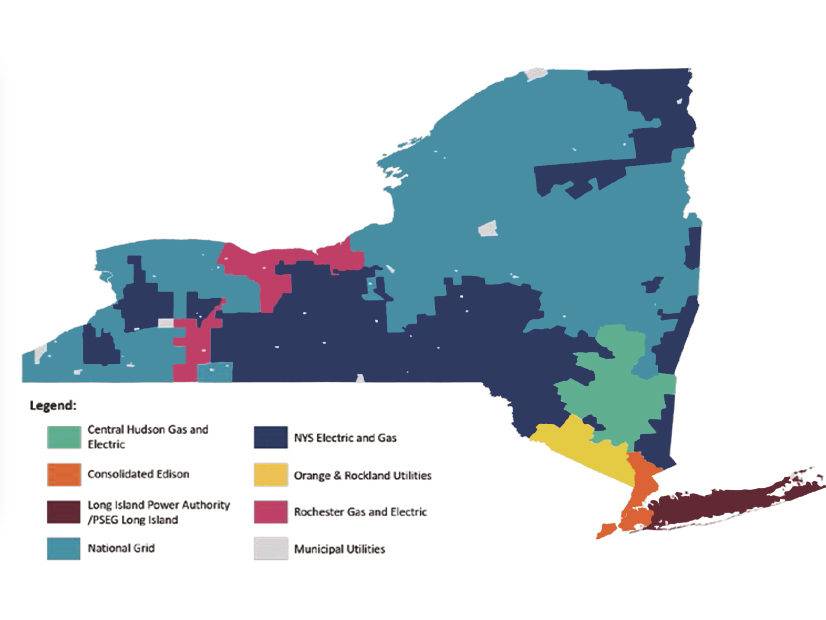
Analyzing Energy Efficiency Trends in New York State
Energy Efficiency Program Spending in New York
From 2013 to 2019, New York State had a budget of $5.3 billion for gas and electric energy efficiency programs, including demand response. This is an average annual investment of $97.80 per capita, assuming a population of 8.5M New Yorkers, placing New York 3rd for its investments, just behind Rhode Island (#2) and Massachusetts (#1). This data comes from the latest available from the Consortium for Energy Efficiency.
How does this compare? While California often ranks #1 in the United States for their energy efficiency programming, California spent an annual average of $42.81 per capita for the same time period, $54.99 per capita less than New York.
In 2021, New York State spent $595.7M on electric energy efficiency programs, and $179.0M on gas energy efficiency programs, for a combined total of $774.7M, per ACEEE’s 2021 Energy Efficiency Scorecard Report. This places New York 3rd among all states for its combined gas and electric efficiency spending.
A collaboration between NYSERDA and six of the state’s investor-owned electric utilities (National Grid, Consolidated Edison [ConEd], New York State Electric & Gas [NYSEG], Orange & Rockland, Rochester Gas & Electric and Central Hudson) are working together to ensure cohesive statewide delivery of programs and budgets.
For example, the collaboration will oversee a $454 million budget, set aside by the New York Climate act in 2020, to achieve 3.6 TBtus savings through increased heat pump adoption. $30 million was also carved out to focus on adoption of heat pumps among communities with low-to-moderate income levels.
The NYSERDA/utilities collaboration will also be responsible for the deployment of an additional $230 million in Market Development investments from NYSERDA.
Did you know?: 74.1% of NY State citizens surveyed by MyHEAT are unaware of any rebates, incentives or other assistance provided by their utility to assist with home energy costs (n=419)
New York’s Energy Efficiency ACEEE State Ranking
As of 2022, New York State has jumped to third place in the ACEEE Annual State Scorecard system.
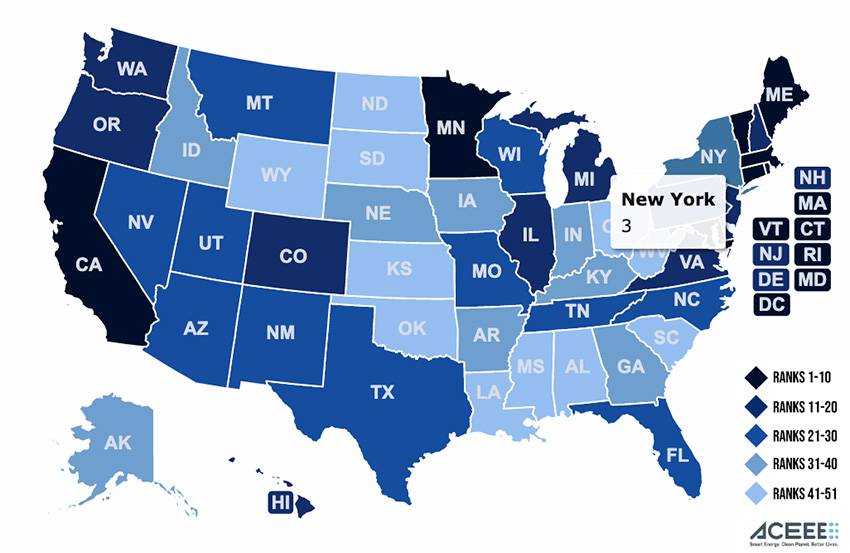
In 2022, New York State improved its position in the most recent annual scorecard produced by our friends at the American Council for an Energy-Efficient Economy (ACEEE), jumping 2 places from 5th place in 2020.
Scoring 8.5 out of a possible 12 points for its policies on ‘Building Energy Efficiency’, New York improved on this category’s score of 6.5 points in ACEEE’s 2020 Scorecard.
ACEEE’s State Scorecard measures a state’s performance across multiple categories, including transportation, supporting policies, and a state’s focus on efforts like supporting low and moderate income communities.
New York Energy Efficiency Programs
New York offers a diverse range of energy efficiency programs for residential, commercial and industrial sectors spanning buildings, transportation and appliances. These programs often include energy efficiency rebates and incentives to encourage participation. Some programs are administered at the state level, some by utility companies and some by municipalities.
The following is a summary of the key residential New York energy savings programs available to New Yorkers, delivered both by NYSERDA and by some of the state’s prominent utility companies.
NYSERDA Home Energy Efficiency Programs
EmPower New York : Low-Income Usage Reduction Program (LIURP)
EmPower New York provides no-cost energy efficiency solutions to income-eligible New Yorkers. Nearly 160,000 of New Yorkers are saving energy and saving money with EmPower New York, with no out-of-pocket expenses.
The EmPower programs provides New Yorkers with free energy upgrades, including:
- A home energy assessment,
- Wall and attic insulation,
- Water-saving showerheads,
- Installation of heat pumps that heat and cool homes cleanly, and more.
Homeowners or renters can participate if income-eligible. In fact, landlords are encouraged to let tenants know they may be eligible for the program.
1. NYS Clean Heat Program
This program is a statewide investment and a coordinated effort delivered by NYSERDA, utilities, and a robust network of contractors, to drive the awareness and adoption of heat pumps in buildings. It aims to save 4 TBtus of energy with high-efficiency heat pumps by 2025.
Many of New York’s gas and electric utilities promote energy efficient heat pumps through this program.
Read more about heat pumps in Europe and what the US can learn from it
2. Comfort Home Program
NYSERDA’s Comfort Home Program offers “seal and insulate packages” to targeted regions of the state, offering between $1,000 and $4,000 depending on the installation conducted.
The Comfort Home Program is designed to reduce the energy requirements of a home by improving its thermal envelope (the heated or cooled interior areas of a building surrounded by walls, windows and roofs). The program starts with a no-fee consultation with a qualified contractor, who can offer recommendations that can include:
- Sealing air leaks
- High R-Value Insulation upgrades for ceilings, floors, and walls
- High performance windows
MyHEAT’s Heat Loss Maps provide a fast and scalable way to alert any energy consumer to opportunities to improve their home’s thermal envelope and make similar energy upgrades provided by the Comfort Home Program. MyHEAT’s program is currently active for over 100,000 National Fuel customers in western New York.
Did you know?: A total of $119,423,187 USD was spent on low-income energy efficiency programs in New York in 2021 (per ACEEE).
RetrofitNY Program
Inspired by the Dutch concept of ‘Energiesprong’, NYSERDA launched the “RetrofitNY” program in 2018 to achieve carbon neutrality for a large number of affordable housing units by 2025.
With a budget of $30M USD, 46 projects are planned to achieve deep energy retrofits for multifamily buildings at-scale using the energiesprong approach.
“We are spearheading the creation of standardized, scalable solutions and processes that will improve the aesthetic and comfort of New York’s buildings while dramatically improving their energy performance.” – NYSERDA
RetrofitNY aims to create demand for this new kind of energy retrofit to stimulate further innovation in the market. NYSERDA hopes the planned projects will help manufacturers and the building industry at large to develop improved scalable solutions for zero-carbon energy-efficient buildings.
A Request for Qualifications (RFQL) is currently open for all electric deep energy retrofit pilot projects targeting the affordable housing stock, with a funding round budget of $5M.
3. Assisted Home Performance with ENERGY STAR Program
For qualifying income-eligible New York State residents who are struggling to pay for energy-efficient home upgrades, the NYSERDA Assisted Home Performance with ENERGY STAR program provides support.
The program provides those who qualify with a discount covering 50% of the cost of eligible energy efficiency improvements up to $5,000 per project for single-family homes. It also provides up to $10,000 for two-to-four-unit residential homes with income-eligible residents.
Utility Energy Efficiency Programs in New York
PSEG Long Island Residential Energy Efficiency Programs
1. PSEG Residential Energy Affordability Partnership (REAP) Program
PSEG’s REAP program helps income-eligible customers lower energy costs by finding energy-saving opportunities for their homes.
If a customer qualifies to participate, a REAP technician will determine the energy efficiency of the home’s appliances and other devices. Customers may qualify to have energy-saving appliances and devices installed in their homes for free.
2. PSEG Home Comfort Program
PSEG’s Home Comfort Program provides rebates for air source heat pumps. Eligible equipment must be purchased from AND installed by participating Home Comfort Partners.
National Fuel Residential Energy Efficiency Programs
Since 2008, National Fuel claims that its programs and rebates made available through the Conservation Incentive Program (CIP) have helped more than 150,000 customers install and upgrade to new, more energy-efficient appliances, achieving total emissions reductions of approximately 1.2 million tons of CO2e.
1. National Fuel Energy Efficiency Rebate Program
A broad rebate program for National Fuel customers in western New York that offers residential customers a variety of financial rebates for replacing specified appliances with new, energy-efficient models. Installs must be made by a contractor.
Rebates start at $25 (for example, for a boiler or furnace tune-up), $50 for a smart thermostat, and grow to up to $1,000 for the installation of an energy-efficient space heating hot air furnace with 95% efficiency.
All rebates are available for existing single-family homes, multi-family homes, condominiums, mobile homes and new builds.
2. MyHEAT: Free Home Heat Loss Report for National Fuel Customers
National Fuel has partnered with MyHEAT to map the thermal heat loss for over 100,000 National Fuel customers in west New York.
The MyHEAT Heat Loss Maps show individual home heat loss and provide information for customers to learn more about energy efficiency, and National Fuel’s rebate programs.
Each mapped home is given a score, or an ‘energy label’ of 1-10, to help them understand how efficient their home is compared to similar homes nearby. This score is an effective behavioral nudge that is proven to prompt customers to take action and apply for help in making their home more energy efficient.
3. Sealed: Insulation, HVAC and Smart Tech Upgrades for National Fuel Clients
National Fuel has also partnered with Sealed, who covers the upfront costs for insulation and smart home technology. Available across New York state, Sealed provides home energy upgrades for homeowners that are paid for by their energy savings.
Sealed covers the upfront costs for the upgrades, which create greater energy efficiency through weatherization, balancing home temperatures and reducing energy waste. Homeowners then pay back Sealed based on how much energy is saved by homes who sign up for the program.
National Grid New York Residential Energy Efficiency Programs
National Grid has three distinct service areas in New York State; Upstate, Metro, and Long Island. The availability of the following programs will vary based on which service area a customer lives in.
1. National Grid No-Cost Online Home Energy Survey
Customers can complete a quick, online home energy survey to receive recommended energy-saving tips for renters and homeowners.
2. National Grid Nest Rush Hour Rewards
If customers have a Google Nest Wi-Fi Thermostat and choose to participate in ‘Rush Hour Rewards’, the Nest thermostat will adjust the home’s temperature by up to 4 degrees during periods of unusually high energy demand on the grid. Customers can opt-out by manually changing their thermostat temperature. Customers who participate in 80% of rush hour events receive various gift card rewards between $20 and $30.
This kind of program is also extended to National Grid customers using ecobee, Honeywell or other similar smart thermostats.
3. National Grid Marketplace
National Grid New York’s marketplace offers its customers the ability to shop for various energy-efficient and ENERGY STAR products with discounts and instant rebates. Products include smart thermostats, lighting, DIY weatherization solutions and more.
4. National Grid Natural Gas Heating Rebates
Rebates are available for customers who upgrade to efficient gas heating upgrades. Rebates start at $50 for pipe insulation and radiator controls, and grow to up to $1,000 for combination boiler-water heaters, and efficient furnaces and boilers.
5. National Grid Electric Heating and Cooling Rebates
In collaboration with NYS Clean Heat, National Grid offers its customers various rebates for installing approved heat pumps. A mini-split heat pumps will net customers up to $400 in rebates, whereas a ground source heat pump installation can provide customers with a rebate of up to $7,000.
Related reading: What does the emergency DPA funding mean for heat pump sales?
6. National Grid Water Heating Rebates
Rebates for more energy-efficient water heating solutions for National Grid customers in New York can range from $250 for a gas storage water heater, up to $700 for an electric heat pump water heater.
ConEdison (ConEd) New York Residential Energy Efficiency Programs
1. ConEd Smart Thermostats and Rush Hour Rewards
ConEd is currently offering customers an instant $50 rebate for the purchase of a smart thermostat through its marketplace.
In addition, customers who enroll their thermostat in ConEd’s peak demand response program (similar to the Nest Rush Hour Reward program) can qualify for an additional $85 rebate.
2. ConEd Heat Pump Rebates
Electric heat pumps for home heating and cooling have proven so popular among ConEd customers that its air source heat pump program is now fully subscribed and no longer offering rebates, as of December 2022.
ConEd continues to offer rebates for geothermal (ground-source) heat pumps of $5,000 per 10,000 Btu/h heating capacity, up to a maximum of $50,000, or 70% of the project’s total cost. This program is administered in part by the NYS Clean Heat program.
3. ConEd Weatherization Rebates
ConEd offers two options for customers to access help weatherizing their homes.
Customers can choose to work with a weatherization contractor from an approved list, and receive an instant discount of $1,000 from any work conducted.
In addition, customers may choose to work with ConEd’s weatherization aggregator, Sealed. Sealed offers financing options which cover the upfront costs of weatherization, with payments made only if customers start saving energy.
Central Hudson Residential Energy Efficiency Programs
1. Central Hudson Smart Thermostat Rebates
Central Hudson offers its customers a $50 discount on approved ENERGY STAR thermostats bought online from specific retailers. It also offers special pricing in-store with approved stores such as Home Depot, Best Buy and hardware stores in its service territory.
2. Central Hudson Electric Heat Pump Water Heaters Rebates
Customers who upgrade to an ENERGY STAR electric heat pump water heater are eligible for a rebate of $1,000 if purchased from Best Buy, Lowe’s or Home Depot.
3. Central Hudson Heat Pump Rebates
Air Source Heat Pump Rebates
If the primary method of heating and cooling, Central Hudson customers can save up to $1,000 per BTU per hour (Btuh), but only if this upgrade is fuel-switching, and that the customer removes their oil tank or other fossil-fuel based heating source.
Ground Source Heat Pump Rebates
Customers can avail of a rebate up to $2,000 per btuh full load AHRI capacity, in addition to federal and state tax credits.
4. Central Hudson Gas Heating Upgrade Rebates
If using an approved Central Hudson Trade Ally, customers can earn rebates between $25 (for an ECM boiler circulator) and $1,800 for a high-efficiency combi-boiler.
5. Central Hudson Pool Pump Rebates
Central Hudson offers a rebate of up to $500 for ENERGY STAR certified variable speed pool pump upgrades.
Other Notable New York State Energy Efficiency programs:
BlocPower: A Clean Energy Solutions Provider
BlocPower focuses on electrification and clean heating and cooling for homes in New York. Incentives are provided for homeowners, depending on multiple factors regarding the building’s electrical supplier, the number of indoor and outdoor heating pumps and the type of building (residential, multi-family and commercial).
BlocPower’s goal for homeowners is to lower total operating costs as well as improving health and comfort.
BlocPower is currently partnered with Con Edison and National Grid in New York State.
Dandelion Geothermal: A Sustainable Heating and Cooling Alternative
The Dandelion Energy Geothermal Program replaces the home’s existing air conditioning and heating equipment with a heat pump and safe, underground pipes that move heat between the earth and the home. Dandelion customers may save up to $1000 on heating and cooling every year.
New York State’s Demographics: Insights for Energy Efficiency Programs
With almost 8.5 million inhabitants, New York state has a diverse population living in the United State’s 27th largest state by area.
Delivering equitable energy efficiency programs in any state requires program administrators to design and provide solutions that cater for all inhabitants, not just those that can afford to make energy upgrades.
Addressing Energy Burden and Income-Eligible Statistics

There is excellent availability of energy efficiency programs intended for income-eligible residents or low-income communities, such as REAP, in New York State. These programs are excellent tools to address energy poverty.
However, there can be barriers to program participation, such as access to low-cost credit, lower than average credit scores, rentership status, and willingness to prioritize energy upgrades over other expenses and bills.
In a 2020 report, the American Council for an Energy Efficiency Economy estimated that the median low-income energy burden for residents in the New York City metropolitan area was 9.3%, and that over 25% of these residents experience an energy burden of over 17%.
In New York, 59.6% of homes use utility gas for heating compared to 12.9% homes that use electricity in 2021. The price of natural gas is $26.17 /thousand cubic feet (as of August 2022), while the price of electricity is $21.20 /kilowatt hours (as of August 2022), the highest it has ever been, increasing utility burden on low income households.
In 2021, the average monthly consumption of electricity was 599kWh and the average price was 19.48 cents/kWh, with an average monthly bill of $116.7 that adds up to $1400.4 in 2021.
Did you know?: Responses from a recent survey conducted by MyHEAT suggest that:
- 57.2% of US residents describe their recent utility energy bills (over the last 12 months) as unaffordable.
- 67.9% of New York State residents describe their recent utility energy bills (over the last 12 months) as unaffordable.
In addition, there are approximately 7.6 million New Yorkers living in counties with an annual median income considered ‘low-income’ – $65,000 or less. Approximately 1.1 million New Yorkers are living in counties with an annual median income of $55,000 or less.
The income disparity between ‘low-income’ and above low-income is most pronounced in the south-eastern area of New York, which includes New York City, as seen in the map below.
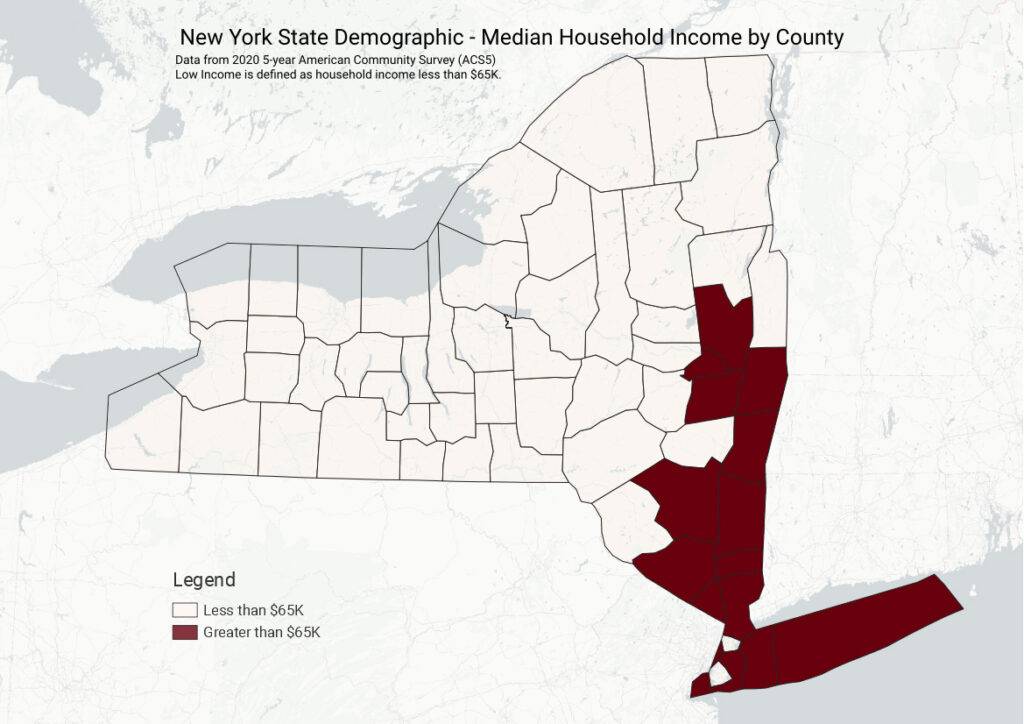
When designing energy efficiency programs, this kind of insight should be considered to ensure an equitable and effective program implementation.
The MyHEAT Heat Loss platform combines individual home heat loss with other data points (such as income, demographics, tax parcel assessment, building type) for better audience segmentation to deliver targeted and personalized energy efficiency messaging. This kind of tailored implementation can help address perceived barriers and drive program participation.
Here are two examples of how the combination of demographic, census, building, and other data, can be combined to influence the message that different segments of New Yorkers could receive:
- Of all residential buildings in counties with a median ‘low-income’ of $65k or less, 67.45% are single-family detached homes. Single family detached homes have different response rates and requirements for participation in programs, and messaging should be adjusted accordingly.
- Of all residents in counties with a median ‘low-income’ of $65k or less, the average percentage of rentership is 30.27%. Renters often struggle to participate in programs, and special consideration should be given to the recipient of program info (ie. tenant .v. landlord) and which upgrades are recommended.
The MyHEAT Heat Loss platform also allows for various building, demographic, income and Heat Loss insights at census tract levels, to inform personalized program design and outreach. An example of this can be seen below.
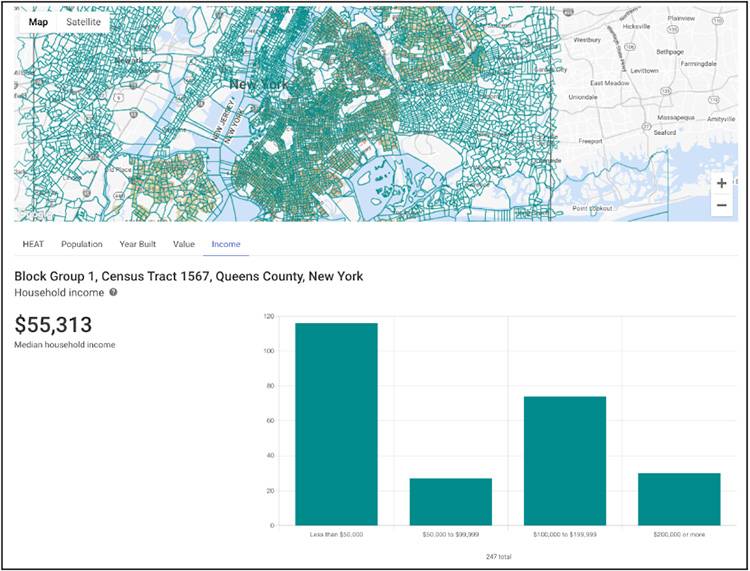
Building Stock Insights Enhanced Energy Efficiency in New York
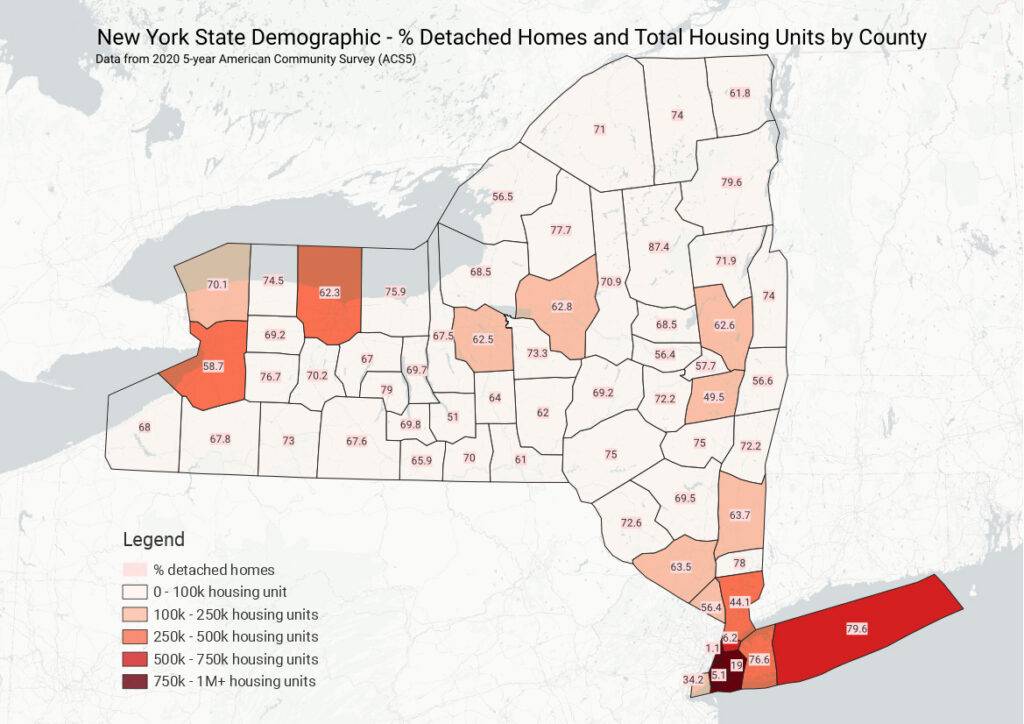
There are approximately 8.3 million buildings in New York State, according to the 2020 5-year American Community Survey. NYSERDA suggests that 500 buildings per day need to be decarbonized over the next 30 years in order to meet the state’s greenhouse gas emission goals. One third of GHG emissions come from heating or cooling buildings in New York, showing great potential in reducing emissions by weatherizing homes and updating technology used.
New York City houses more renters (over 60%) than owners, most of whom spend greater than 35% of their household income on housing, according to the 2020 5-year American Community Survey. Most of these renters (48.4%) live in buildings with 20 or more units. Understanding this kind of insight can improve how energy efficiency messages are delivered to such customers.
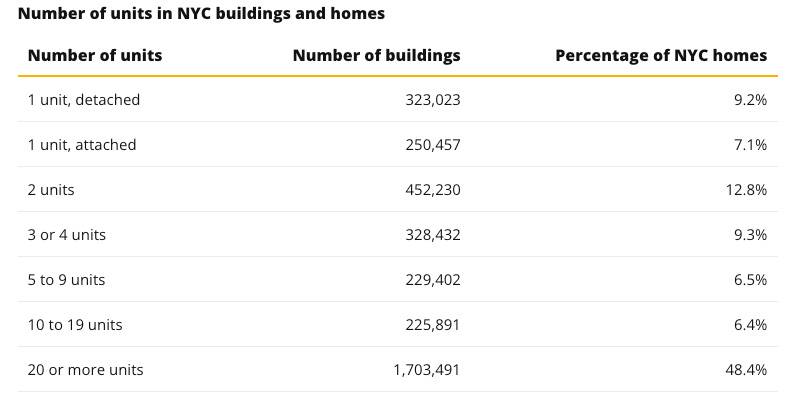
By understanding the energy burden of each home in a city like New York, as measured by an energy efficiency rating scale label like MyHEAT’s HEAT rating, energy efficiency programs can be designed to maximize response rates, message effectiveness, and ultimately, program uplift.
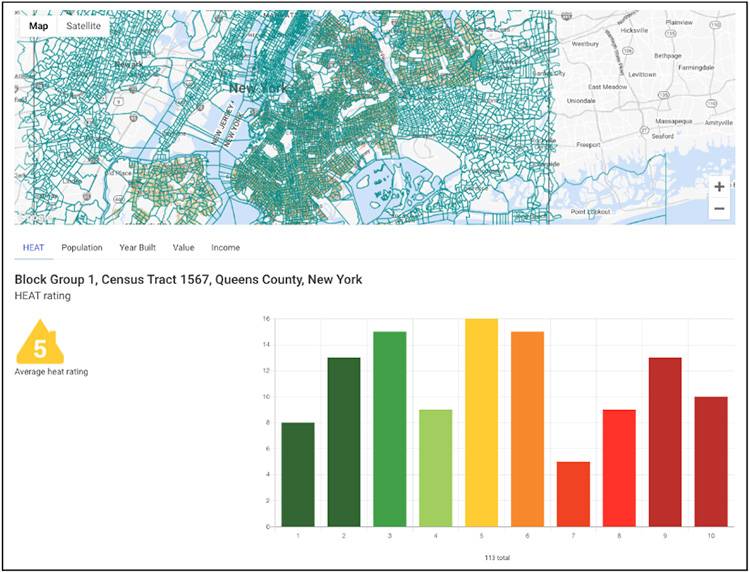
The Future of Energy Efficiency in New York State
On December 19th 2022, NYSERDA announced the release and approval of their final Scoping Plan. This plan outlines the recommended policies and actions designed to meet the goals laid out by the progressive Climate Act passed in 2019.
While the Climate Act was passed 3 years ago, NYSERDA President and CEO Doreen Harris says “We now have an action plan to follow to ensure we meet these critical goals. Today is certainly a day to celebrate, but this also marks the beginning of more significant work to come as we forge the path ahead and lead by example on how to transition an economy based on the conventional energy practices of yesterday to the thriving green economy of tomorrow.”
The NYSERDA Scoping Plan also “prioritizes Disadvantaged Communities and the creation of good, family-sustaining, union jobs accessible to all New Yorkers.”
This is good news for energy efficiency in New York – expect increased investment in existing and new NYSERDA programs, gas and electric utility programs, and a growing focus on energy equity and justice throughout the state.
As for this report, expect updates that will provide more detail on success stories from New York, comparisons to other U.S. states, and efforts that focus on Disadvantaged Communities.
Maximize Energy Efficiency in New York with MyHEAT
Ready to boost energy efficiency in New York? Discover the power of MyHEAT’s heat loss maps and how they can drive program participation through our unique heat loss imagery tailored for behavioral and marketing campaigns. Collaborate with MyHEAT and contribute to New York’s sustainable progress.
